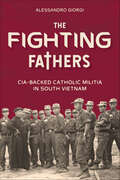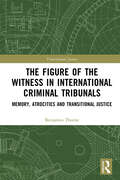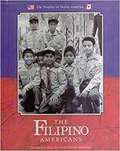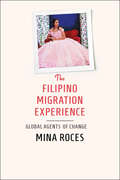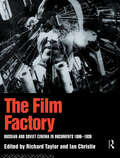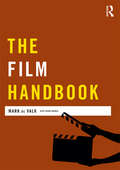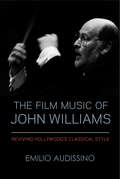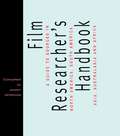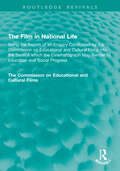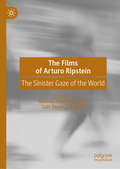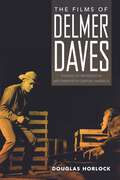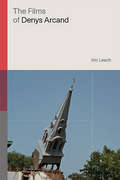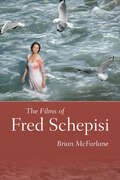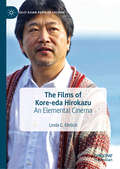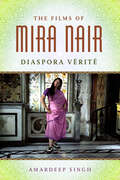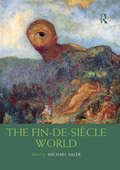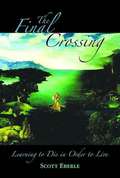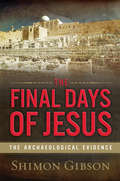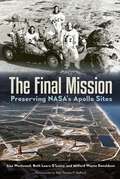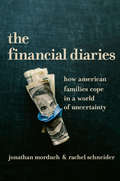- Table View
- List View
The Fighting Fathers: CIA-Backed Catholic Militia in South Vietnam
by Alessandro GiorgiAn untold story of espionage, religion, and guerilla warfare in South Vietnam. During the early years of US involvement in Vietnam, the CIA helped arm militia groups in South Vietnam referred to as the “Fighting Fathers.” The name was a reference to the Catholic priests who organized the fighting groups. The fathers fought alongside their parishioners to defend their localities from the Communist insurgency, the Vietcong. Author Alessandro Giorgi has studied the subject in unprecedented detail, conducting original research in recently declassified archives and interviewing former US intelligence personnel and Italian missionary witnesses.
The Figure of the Teacher in Comics: A Psychoanalytic Study of Immaterial and Fragmented Education
by David LewkowichThis book explores the distinctive narrative and representational gestures used to portray the personal and professional lives of teachers in comics. While serving as a reference for conceptualizing teachers in literary and popular culture, this book also turns to comics as a means to better understand and interpret lived, emotional experiences of teaching. Lewkowich discusses the cultural history of teachers in North American comics, and provides a series of thematic studies on the split and secret identities of teachers, teacher’s deaths by murder, and the teacher’s relationship to the thought bubble. He also outlines the psychic and social consequences of reading and making comics with preservice teachers.
The Figure of the Witness in International Criminal Tribunals: Memory, Atrocities and Transitional Justice
by Benjamin ThorneThis book analyses how international criminal institutions, and their actors – legal counsels, judges, investigators, registrars – construct witness identity and memory. Filling an important gap within transitional justice scholarship, this conceptually led and empirically grounded interdisciplinary study takes the International Criminal Tribunal for Rwanda (ICTR) as a case study. It asks: How do legal witnesses of human rights violations contribute to memory production in transitional post-conflict societies? Witnessing at tribunals entails individuals externalising memories of violations. This is commonly construed within the transitional justice legal scholarship as an opportunity for individuals to ensure their memories are entered into an historical record. Yet this predominant understanding of witness testimony fails to comprehend the nature of memory. Memory construction entails fragments of individual and collective memories within a contestable and contingent framing of the past. Accordingly, the book challenges the claim that international criminal courts and tribunals are able to produce a collective memory of atrocities; as it maintains that witnessing must be understood as a contingent and multi-layered discursive process. Contributing to the specific analysis of witnessing and memory, but also to the broader field of transitional justice, this book will appeal to scholars and practitioners in these areas, as well as others in legal theory, global criminology, memory studies, international relations, and international human rights.
The Filing Cabinet: A Vertical History of Information
by Craig RobertsonThe history of how a deceptively ordinary piece of office furniture transformed our relationship with information The ubiquity of the filing cabinet in the twentieth-century office space, along with its noticeable absence of style, has obscured its transformative role in the histories of both information technology and work. In the first in-depth history of this neglected artifact, Craig Robertson explores how the filing cabinet profoundly shaped the way that information and data have been sorted, stored, retrieved, and used.Invented in the 1890s, the filing cabinet was a result of the nineteenth-century faith in efficiency. Previously, paper records were arranged haphazardly: bound into books, stacked in piles, curled into slots, or impaled on spindles. The filing cabinet organized loose papers in tabbed folders that could be sorted alphanumerically, radically changing how people accessed, circulated, and structured information.Robertson&’s unconventional history of the origins of the information age posits the filing cabinet as an information storage container, an &“automatic memory&” machine that contributed to a new type of information labor privileging manual dexterity over mental deliberation. Gendered assumptions about women&’s nimble fingers helped to naturalize the changes that brought women into the workforce as low-level clerical workers. The filing cabinet emerges from this unexpected account as a sophisticated piece of information technology and a site of gendered labor that with its folders, files, and tabs continues to shape how we interact with information and data in today&’s digital world.
The Filipino Americans
by Jennifer SternDiscusses the history, culture, and religion of the Filipinos, factors encouraging their emigration; and their acceptance as an ethnic group in North America.
The Filipino Migration Experience: Global Agents of Change
by Mina RocesThe Filipino Migration Experience introduces a new dimension to the usual depiction of migrants as disenfranchised workers or marginal ethnic groups. Mina Roces suggests alternative ways of conceptualizing Filipino migrantsas critics of the family and cultural constructions of sexuality, as consumers and investors, as philanthropists, as activists, and, as historians. They have been able to transform fundamental social institutions and well-entrenched traditional norms, as well as alter the business, economic and cultural landscapes of both the homeland and the host countries to which they have migrated. Mina Roces tells the story of the Filipino migration experience from the perspective of the migrants themselves, tapping into hitherto underused primary sources from the "migrant archives" and more than 70 interviews. Bringing the fields of Filipino migration studies and Filipina/o/x American studies together, this book analyzes some of the areas where Filipino migrants have forever changed the status quo.
The Film Factory: Russian and Soviet Cinema in Documents 1896-1939 (Soviet Cinema Ser.)
by Richard Taylor Ian Christie Professor Richard TaylorFirst Published in 1994. Routledge is an imprint of Taylor & Francis, an informa company.
The Film Handbook (Media Practice)
by Mark De Valk Sarah ArnoldThe Film Handbook examines the current state of filmmaking and how film language, technique and aesthetics are being utilised for today’s ‘digital film’ productions. It reflects on how critical analysis’ of film underpins practice and story, and how developing an autonomous ‘vision’ will best aid student creativity. The Film Handbook offers practical guidance on a range of traditional and independent ‘guerrilla’ film production methods, from developing script ideas and the logistics of planning the shoot to cinematography, sound and directing practices. Film professionals share advice of their creative and practical experiences shooting both on digital and film forms. The Film Handbook relates theory to the filmmaking process and includes: • documentary, narrative and experimental forms, including deliberations on ‘reading the screen’, genre, mise-en-scène, montage, and sound design • new technologies of film production and independent distribution, digital and multi-film formats utilised for indie filmmakers and professional dramas, sound design and music • the short film form, theories of transgressive and independent ‘guerrilla’ filmmaking, the avant-garde and experimental as a means of creative expression • preparing to work in the film industry, development of specialisms as director, producer, cinematographer, editor, and the presentation of creative work.
The Film Music of John Williams: Reviving Hollywood's Classical Style (Wisconsin Film Studies)
by Emilio AudissinoFrom the triumphant “Main Title” in Star Wars to the ominous bass line of Jaws, John Williams has penned some of the most unforgettable film scores—while netting more than fifty Academy Award nominations. This updated and revised edition of Emilio Audissino’s groundbreaking volume takes stock of Williams’s creative process and achievements in music composition, including the most recent sequels in the film franchises that made him famous. Audissino discusses Williams’s unique approach to writing by examining his neoclassical style in context, demonstrating how he revived and revised classical Hollywood music. This volume details Williams’s lasting impact on the industry and cements his legacy as one of the most important composers in movie history. A must for fans and film-music lovers alike.
The Film Researcher's Handbook: A Guide to Sources in North America, Asia, Australasia and Africa (Blueprint Ser.)
by Jenny MorganThe Film Researcher's Handbook is a comprehensive reference guide to international film and video libraries, archives and collections. The Handbook will enable researchers to select footage sources by subject and location in North and South American, Asia, Australasia and Africa.Features of the Handbook include: * A guide to the perils and pitfalls of footage research * Information on fees, rights, copyright legislation and contracts * A glossary of key terms in film research * Over 200 sources listed alphabetically both by country and by subject * Each entry gives details of opening hours, contact information, subjects and format of material held and research procedure
The Film in National Life: Being the Report of an Enquiry Conducted by the Commission on Educational and Cultural Films into the Service which the Cinematograph May Render to Education and Social Progress (Routledge Revivals)
by The Commission on Educational and Cultural FilmsThe Film in National Life (1932) is the report by the Commission on Educational and Cultural Films, established in 1929, that aimed to establish a position on the treatment of film constructively in the interests of education in its widest sense. The Commission was aware that other countries were taking the film seriously as an instrument of visual and aural instruction, as a means of entertainment, and as an art form, and sought to adopt a similar rational approach in the UK.
The Films of Arturo Ripstein: The Sinister Gaze of the World
by Manuel Gutiérrez Silva Luis Duno GottbergThis book gathers eleven scholarly contributions dedicated to the work of Mexican director Arturo Ripstein. The collection, the first of its kind, constitutes a sustained critical engagement with the twenty-nine films made by this highly acclaimed yet under-studied filmmaker. The eleven essays included come from scholars whose work stands at the intersection of the fields of Latin American and Mexican Film Studies, Gender and Queer Studies, Cultural Studies, History and Literary studies. Ripstein’s films, often scripted by his long-time collaborator, Paz Alicia Garciadiego, represent an unprecedented achievement in Mexican and Latin American film. Unlike many of his contemporaries, Ripstein has successfully maintained a prolific output unmatched by any director in the region. Though several book-length studies have been published in Spanish, French, German, and Greek, to date no analogue exists in English. This volume provides a much-needed contribution to the field.
The Films of Delmer Daves: Visions of Progress in Mid-Twentieth-Century America
by Douglas HorlockDelmer Daves (1904–1977) was an American screenwriter, director, and producer known for his dramas and Western adventures, most notably Broken Arrow and 3:10 to Yuma. Despite the popularity of his films, there has been little serious examination of Daves’s work. Filmmaker Bertrand Tavernier has called Daves the most forgotten of American directors, and to date no scholarly monograph has focused on his work.In The Films of Delmer Daves: Visions of Progress in Mid-Twentieth-Century America, author Douglas Horlock contends that the director’s work warrants sustained scholarly attention. Examining all of Daves’s films, as well as his screenplays, scripts that were not filmed, and personal papers, Horlock argues that Daves was a serious, distinctive, and enlightened filmmaker whose work confronts the general conservatism of Hollywood in the mid-twentieth century. Horlock considers Daves’s films through the lenses of political and social values, race and civil rights, and gender and sexuality. Ultimately, Horlock suggests that Daves’s work—through its examination of bigotry and irrational fear and depiction of institutional and personal morality and freedom—presents a consistent, innovative, and progressive vision of America.
The Films of Denys Arcand (Global Film Directors)
by Jim LeachDenys Arcand is best known outside Canada for three films that were nominated for Academy Awards for Best Foreign-Language Film: The Decline of the American Empire (1986), Jesus of Montreal (1989), and The Barbarian Invasions (2003), the last of which won the Award. Yet Arcand has been making films since the early 1960s. When he started making films, Quebec was rapidly transforming from a relatively homogeneous community, united by its Catholic faith and French language and culture, into a more fragmented modern society. The Films of Denys Arcand sheds light on how Arcand addressed the impact of these changes from the 1960s, when the long-drawn-out debate on Quebec's possible separation from the rest of Canada began, to the present, in which the traditional cultural heritage has been further fragmented by the increasing presence of diasporic communities. His career and films offer an ideal case study for exploring the contradictions and tensions that have shaped Quebec cinema and culture in a period of increasing globalization and technological change.
The Films of Douglas Sirk: Exquisite Ironies and Magnificent Obsessions
by Tom RyanBest known for powerful 1950s melodramas like All That Heaven Allows, Written on the Wind, The Tarnished Angels, and Imitation of Life, Douglas Sirk (1897–1987) brought to all his work a distinctive style that led to his reputation as one of twentieth-century film’s great directors. Sirk worked in Europe during the 1930s, mainly for Germany’s UFA studios, and then in America in the 1940s and ’50s. The Films of Douglas Sirk: Exquisite Ironies and Magnificent Obsessions provides an overview of his entire career, including Sirk’s work on musicals, comedies, thrillers, war movies, and westerns. One of the great ironists of the cinema, Sirk believed rules were there to be broken. Whether defying the decrees of Nazi authorities trying to turn film into propaganda or arguing with studios that insisted characters’ problems should always be solved and that endings should always restore order, what Sirk called “emergency exits” for audiences, Sirk always fought for his vision. Offering fresh insights into all of the director’s films and situating them in the culture of their times, critic Tom Ryan also incorporates extensive interview material drawn from a variety of sources, including his own conversations with the director. Furthermore, his enlightening study undertakes a detailed reconsideration of the generally overlooked novels and plays that served as sources for Sirk’s films, as well as providing a critical survey of previous Sirk commentary, from the time of the director’s “rediscovery” in the late 1960s up to the present day.
The Films of Fred Schepisi
by Brian McFarlaneFred Schepisi is one of the crucial names associated with the revival of the Australian film industry in the 1970s. The Films of Fred Schepisi traces the lead-up to his critical successes in feature filmmaking, via his earlier award-winning success as a producer in advertising commercials in the 1960s and the setting up of his own company. Unlike some directors, he derived from this experience a sure sense of the commercial aspects of filmmaking, as well as its aesthetic considerations. The volume also considers stories of his early education in a Catholic seminary, which he drew on in his semiautobiographical film, The Devil’s Playground, the success of which launched him as an exciting new feature director. The volume expands on Schepisi’s success story to chart his development as a director in demand in other countries, notably in the US and the UK, as well as continuing to make major films in Australia. Brian McFarlane argues that Schepisi’s career is symptomatic of Australian directors who have made their presences felt on the international stage. Whereas other key directors of the Australian film revival, such as Peter Weir and Bruce Beresford, have been the subject of book-length critical studies, Schepisi’s career has not to-date been so explored. McFarlane takes a critical account of Schepisi’s film output—including such standouts as The Chant of Jimmie Blacksmith, Plenty, Roxanne, Six Degrees of Separation, Mr. Baseball, and Last Orders—and he augments analysis with interviews with the director. By discussing the production histories and both critical and popular receptions, McFarlane’s study shines a new light on Schepisi’s work and his rise to prominence in the global film industry.
The Films of Kore-eda Hirokazu: An Elemental Cinema (East Asian Popular Culture)
by Linda C. EhrlichThe Films of Kore-eda Hirokazu: An Elemental Cinema draws readers into the first 13 feature films and 5 of the documentaries of award-winning Japanese film director Kore-eda Hirokazu. With his recent top prize at the Cannes Film Festival for Shoplifters, Kore-eda is arguably Japan’s greatest living director with an international viewership. He approaches difficult subjects (child abandonment, suicide, marginality) with a realistic and compassionate eye.The lyrical tone of the writing of Japanese film scholar Linda C. Ehrlich perfectly complements the understated, yet powerful, tone of the films. From An Elemental Cinema, readers will gain a special understanding of Kore-eda’s films through a novel connection to the natural elements as reflected in Japanese traditional aesthetics.An Elemental Cinema presents Kore-eda’s oeuvre as a connected whole with overarching thematic concerns, despite frequent generic experimentation. It also offers an example of how the poetics of cinema can be practiced in writing, as well as on the screen, and helps readers understand the films of this contemporary director as works of art that relate to their own lives.
The Films of Mira Nair: Diaspora Verite
by Amardeep SinghThe Films of Mira Nair: Diaspora Vérité presents the first, full-length scholarly study of her cinema. Mira Nair has broken new ground as both a feminist filmmaker and an Indian filmmaker. Several of her works, especially those related to the South Asian diaspora, have been influential around the globe. Amardeep Singh delves into the complexities of Nair’s films from 1981 to 2016, offering critical commentary on all of Nair’s major works, including her early documentary projects as well as shorts. The subtitle, “diaspora vérité,” alludes to Singh’s primary theme: Nair’s filmmaking project is driven aesthetically by her background in the documentary realist tradition (cinéma vérité) and thematically by her interest in the lives of migrants and diasporic populations. Mainly, Nair’s filmmaking intends to document imaginatively the experiences of diasporic communities.Nair’s focus on the diasporic appears in the long list of her films that have explored the subject, such as Mississippi Masala, So Far from India, Monsoon Wedding, The Perez Family, My Own Country, The Namesake, and The Reluctant Fundamentalist. However, a version of the diasporic sensibility also emerges even in films with an apparently different scope, such as Nair’s adaptation of Thackeray’s Vanity Fair.Nair began her career as a documentary filmmaker in the early 1980s. While Nair now has largely moved away from the documentary format in favor of making fictional feature films, Singh shows that a documentary realist style remains active in her subsequent fictional cinema.
The Fin-de-Siècle World (Routledge Worlds)
by Michael SalerThis comprehensive and beautifully illustrated collection of essays conveys a vivid picture of a fascinating and hugely significant period in history, the Fin de Siècle. Featuring contributions from over forty international scholars, this book takes a thematic approach to a period of huge upheaval across all walks of life, and is truly innovative in examining the Fin de Siècle from a global perspective. The volume includes pathbreaking essays on how the period was experienced not only in Europe and North America, but also in China, Japan, the Middle East, Latin America, Africa, India, and elsewhere across the globe. Thematic topics covered include new concepts of time and space, globalization, the city, and new political movements including nationalism, the "New Liberalism", and socialism and communism. The volume also looks at the development of mass media over this period and emerging trends in culture, such as advertising and consumption, film and publishing, as well as the technological and scientific changes that shaped the world at the turn of the nineteenth century, such as the invention of the telephone, new transport systems, eugenics and physics. The Fin-de-Siècle World also considers issues such as selfhood through chapters looking at gender, sexuality, adolescence, race and class, and considers the importance of different religions, both old and new, at the turn of the century. Finally the volume examines significant and emerging trends in art, music and literature alongside movements such as realism and aestheticism. This volume conveys a vivid picture of how politics, religion, popular and artistic culture, social practices and scientific endeavours fitted together in an exciting world of change. It will be invaluable reading for all students and scholars of the Fin-de-Siècle period.
The Final Crossing: Learning to Die in Order to Live
by Scott Eberle"The River Styx isn't far ahead. When it's time for the final crossing, doc, I want you there at the helm." Hearing these words from Steven Foster, hospice physician Scott Eberle unhesitatingly responded, "I give you my word, Steven. If it's within my powers, I'll be there." In a matter of weeks, Steven would be dead, having succumbed to a genetic lung disease at the young age of 64. THE FINAL CROSSING is the story of the journey these two people made together across the river that separates the living from the dead. Steven and his wife, Meredith, had spent nearly thirty years exploring, creating, and enacting wilderness rites of passage - a form of symbolic death. Scott had spent nearly twenty years learning to help others through the rite of passage that is physical death, and more recently he had also begun working as a wilderness guide. As Scott writes in the book, "while symbolic dying and literal dying are obviously not the same, they are deeply connected". During Steven's final days, the lessons they taught each other -- about symbolic and physical death -- were profound. As an old medieval prayer says, "To be blessed in death, one must learn to live. To be blessed in life, one must learn to die". Visit www.thefinalcrossing.com. "This book is itself a right of passage. Extraordinary insights shared by two remarkable people, one dying, the other the inner life and decisions of the physician and friend attending this fine fellow preparing to head into death. This is the best work of its sort I have come across. There are so many levels, so many books in this book that it might well become a teaching text in many classrooms". Stephen Levine, author of "Who Dies?," "Healing into Life and Death" and "A Year to Live".
The Final Days of Jesus: The Archaeological Evidence
by Shimon GibsonAnalyzing the archaeological data sources documenting the days leading to the crucifixion, “this book is destined to become the standard in the field.” (Prof. James D. Tabor, author of The Jesus Dynasty) Unraveling the mystery of Jesus's last days, world-renowned scholar Shimon Gibson reveals how archaeology has a major role to play not only in how the gospels should be read and understood, but also in understanding Jesus in his world.Inside you'll find:the actual site of the execution of Jesusstartling new information about the crucifixion based on the discovery of a first-century crucified manthe surprising location of the trial of Jesusthe truth about his final resting place“A well-written guide to the archaeology behind Jesus’ death and burial, written by one of Jerusalem’s finest archaeologists.” —Jonathan L. Reed, author of the HarperCollins Visual Guide to the New Testament“Gibson synthesizes evidence from archaeology and the New Testament to craft a clear and enjoyable account.” —Jodi Magness, Professor of Early Judaism, University of North Carolina at Chapel Hill“Rigorously scientific, and frequently brilliant. A must read.” —James H. Charlesworth, George L. Collord Professor of New Testament Language and Literature, Princeton University“An expert archaeologist’s valuable insights on the final days of Jesus.” —Geza Vermes, FBA, University of Oxford, author of Jesus the Jew and The Passion“Gibson’s book punctures fourth century mythology with first century evidence drawn from intimate knowledge of the great city of Jerusalem. . . . [A] provocative series of observations and insights.” —Herb Krosney, author of The Lost Gospel: The Quest for the Gospel of Judas Iscariot
The Final Mission: Preserving NASA's Apollo Sites
by Lisa Westwood Beth O'Leary Milford W. DonaldsonThe world will always remember Neil Armstrong and Buzz Aldrin for their first steps on the moon, yet few today hold in respect the sites that made these and other astronauts' journeys possible. Across the American landscape and on the lunar surface, many facilities and landing sites linked to the Apollo program remain unprotected. Some have already crumbled to ruins--silent and abandoned. The Final Mission explores these key locations, reframes the footprints and items left on the moon as cultural resources, and calls for the urgent preservation of this space heritage. Beginning with the initiation of the space race, the authors trace the history of research, training, and manufacturing centers that contributed to lunar exploration. From the early rocket test stands of Robert H. Goddard, to astronaut instruction at Meteor Crater, to human and primate experiments at Holloman Air Force Base, innumerable places proved critical to developing the equipment for exploring space, surviving the journey, and returning to Earth safely. Despite their significance to the history of human spaceflight, many landmarks face the threat of damage or destruction. Most alarming is that the rapid advancement of technology renders stations obsolete long before they are deemed worthy of preservation. Moreover, the lack of precedence for protecting off-planet artifacts poses a unique challenge for space archaeology. While NASA's 2011 recommendations for spacefarers suggest avoiding close proximity to this cultural landscape, the authors advocate stronger routes of preservation and present models for safeguarding space history--both on Earth's surface and beyond.
The Finance Curse: How Global Finance Is Making Us All Poorer
by Nicholas ShaxsonAn “artfully presented [and] engaging” look at the insidious effects of financialization on our lives and politics by the author of Treasure Islands (The Boston Globe).How didthe banking sector grow from a supporter of business to the biggest business in the world? Financial journalist Nicholas Shaxson takes us on a terrifying journey through the world economy, exposing tax havens, monopolists, megabanks, private equity firms, Eurobond traders, lobbyists, and a menagerie of scoundrels quietly financializing our entire society, hurting both business and individuals.Shaxson shows how we got here, telling the story of how finance re-engineered the global economic order in the last half-century, with the aim not of creating wealth but extracting it from the underlying economy. Under the twin gospels of “national competitiveness” and “shareholder value,” megabanks and financialized corporations have provoked a race to the bottom between states to provide the most subsidized environment for big business, encouraged a brain drain into finance, fostered instability and inequality, and turned a blind eye to the spoils of organized crime. From Ireland to Iowa, he shows the insidious effects of financialization on our politics and on communities who were promised paradise but got poverty wages instead.We need a strong financial system—but when it grows too big it becomes a monster. The Finance Curse is the explosive story of how finance got a stranglehold on society, and reveals how we might release ourselves from its grasp.Revised with new chapters“[Discusses] corrupt financiers in London and New York City, geographically obscure tax havens, the bizarre realm of wealth managers in South Dakota, a ravaged newspaper in New Jersey, and a shattered farm economy in Iowa . . . A vivid demonstration of how corruption and greed have become the main organizing principles in the finance industry.” —Kirkus Reviews
The Financial Crisis and White Collar Crime - Legislative and Policy Responses: A Critical Assessment (The Law of Financial Crime)
by Nicholas Ryder Umut Turksen Jon TuckerThis book offers a commentary on the responses to white collar crime since the financial crisis. The book brings together experts from academia and practice to analyse the legal and policy responses that have been put in place following the 2008 financial crisis. The book looks at a range of topics including: the low priority and resources allocated to fraud; EU regulatory efforts to fight financial crime; protecting whistleblowers in the financial industry; the criminality of the rogue trader; the evolution of financial crime in cryptocurrencies; and the levying of financial penalties against banks and corporations by the US Department of Justice and Securities and Exchange Commission.
The Financial Diaries: How American Families Cope in a World of Uncertainty
by Jonathan Morduch Rachel SchneiderWhat the financial diaries of working-class families reveal about economic stresses, why they happen, and what policies might reduce themDeep within the American Dream lies the belief that hard work and steady saving will ensure a comfortable retirement and a better life for one's children. But in a nation experiencing unprecedented prosperity, even for many families who seem to be doing everything right, this ideal is still out of reach.In The Financial Diaries, Jonathan Morduch and Rachel Schneider draw on the groundbreaking U.S. Financial Diaries, which follow the lives of 235 low- and middle-income families as they navigate through a year. Through the Diaries, Morduch and Schneider challenge popular assumptions about how Americans earn, spend, borrow, and save—and they identify the true causes of distress and inequality for many working Americans. We meet real people, ranging from a casino dealer to a street vendor to a tax preparer, who open up their lives and illustrate a world of financial uncertainty in which even limited financial success requires imaginative—and often costly—coping strategies. Morduch and Schneider detail what families are doing to help themselves and describe new policies and technologies that will improve stability for those who need it most.Combining hard facts with personal stories, The Financial Diaries presents an unparalleled inside look at the economic stresses of today's families and offers powerful, fresh ideas for solving them.
